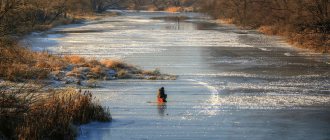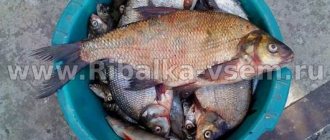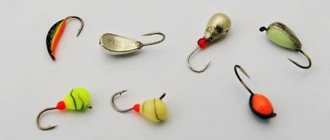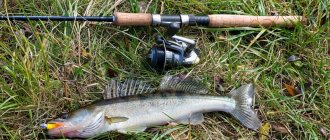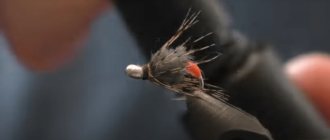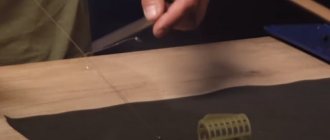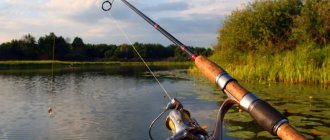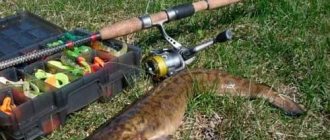Fishing from a boat on many small artificial reservoirs does not make much sense due to their small size. Therefore, it is better to practice coastal spinning fishing here. And while the new season has not gained its momentum, so to speak, you can be content with short forays into small reservoirs, quarries, ponds, etc. Moreover, without the hassle of assembling and disassembling the boat in one trip, it is often possible to visit several such bodies of water. Spinning fishing on them may not be as varied as on rivers, but it is often also quite rewarding and unexpected.
Spinning fishing in reservoirs
I still usually leave reservoirs for the boat, believing that only from a watercraft can one get to promising places. However, there are areas on reservoirs where the predator often stays within reach of shore casting. Sometimes you don’t even need to send the bait far, just throw the riverbed across - and you can make a high-quality step-by-step jig. We are talking about the lower reaches of reservoirs - areas near outlet locks and dams.
As a rule, the coast here is dammed, so it is easily passable. The depth of the dams is also quite good, which is what predators take advantage of. Usually in such places I rely more on perch - it just so happens that this is what I managed to catch en masse near various hydraulic structures. However, there were fishing trips that made it clear that there was a place for pike here too.
For example, on one of my first spinning fishing trips last year, I was so impatient to cast the bait faster that I did it right from the dam right next to the car. After casting, the bait flew over the riverbed, passed perpendicular to it and climbed out into the shallow coastal waters. This kind of relief wiring was normal, although not very long.
And what do you think: on the 4th cast I feel a weak blow on the pause at the very bottom - and a small pike on the shore. The next two casts brought approximately the same pikes - the 5th and 6th, respectively. Only the nature of the bites was different: one exactly repeated the first one by nodding the tip of the spinning rod, when the bait just began to slide into the riverbed, the other happened according to the classics - a high-quality strike on a pause, already on the way up the slope. This is the beginning!
By that time the guys had only just managed to uncover their spinning rods. However, further fishing of the area near the dam did not bring any bites, and we went to explore the reservoir upstream. it works without problems. And it’s better to do this with a jig - then you can get a good feel for the relief and understand how the riverbed runs. If the reservoir is wide and the coastal area is quite shallow, other baits come into play. In such places, with a maximum depth of usually one and a half to two meters, I prefer to twitch. Of course, not every wobbler flies as far as we would like, and therefore here you become quite demanding of wobblers.
I would call the Duo Moab F wobbler one of the most volatile in my coastal collection, preferably in size 120, but I also use 85. I somehow caught the first one on the first cast with a pike at 3700 g, since then I believe in it and keep it as "super intelligence officer" Another favorite representative of the twitching trend is the Lucky John Jerky Minnow wobbler. It was produced in only one size - 10 cm. The ball system installed in it also allows you to make long-distance and accurate casts. Perhaps this is the most noisy wobbler in my collection. The depth of the wiring is up to 1–1.2 m. I like to lead wobblers with a “rattle” not only with classic twitching, but also with uniform wiring with pauses.
There are suspicions that the noise of rolling balls when the wobbler stops also attracts pike. Under the Lucky John brand I also have, perhaps, the fastest pop-up wobbler - X? Twitch. It comes in three sizes - 7, 9 and 11 cm, but I often use the last two - larger ones. The X?Twitch wobbler pops up so quickly that I move it without pauses, but with constant twitching of the tip of the spinning rod while rotating the reel evenly.
When retrieving slowly, the wobbler allows you to move close to the surface, which is often also necessary. Finishing the topic of long-range wobblers, I must say about the longest-firing wobbler I have ever encountered. This is the Salmo Slider 7 - a mini version of the legendary jerkbait. Both the floating and sinking versions easily “break through” the wind, and can fly 70–80 meters along it.
These are also representatives of the “shallow-water fraction” of wobblers, which successfully allow fishing the coastal zone of reservoirs. I often lead the floating version of the Salmo Slider 7 wobbler evenly, with constant frequent and small jerks; I periodically offer pauses for the sinking version. Osko has models similar to the Polish Slider. These are 3 produced versions of gliders, united by the name Jerk - Jerk itself, also Jerk-R and Jerk-Bass. Unlike Salmo Slider 7, they are produced only in a sinking version. At the same time, they glide very well, both on short and long jerks. Allows you to fish a deeper horizon with minor pauses or slow retrieval.
For fishing with wobblers using the jerk method, I usually use a kit called X-Twitch. This is a Salmo Elite X-Twitch spinning rod with a length of 1.98 m and a test of 5–25 g, a reel of the same name, twitch braid with a diameter of 0.12 mm and leads made of titanium wire, which help to avoid overlaps. As for the shallowest waters, where there may be shallow depth or underwater vegetation will approach the very surface of the water, then the bladeless sinking Lucky John Rolling Minnow would be an acceptable option.
By changing the speed of the wiring, you can vary the depth of its passage right up to the surface. And any changes in the game can lead to a bite. Another option for shallow water fishing is the use of silicone baits on an offset hook. Already at the beginning of summer, some places in reservoirs can be so overgrown that even a wobbler running just under the surface will cling to the grass every now and then.
When I visited this reservoir last year, I noticed the abundance of frogs in some places. Having compared the collected information, I made calculations for imitation when guiding these amphibians - for catching I picked up a large two-tailed twister, very similar to a frog. He led the silicone bait with smooth jerks in the upper layer of water, making them either the tip of a spinning rod, or a reel, or both at the same time. The calculation worked, and the first bites of small pike began immediately.
True, the offset hook did not provide good bites, and the casting range was small. Therefore, in those places where there was less vegetation, I already used a different equipment on the old bait - either a double with a Cheburashka weight of greater weight, or a jig head. The wiring is still the same - constant unsharp jerks in the water column, a kind of pelagic twitching.
Infrastructure on quarry beaches
There are several cafes on the beach, ice cream is sold, there are gazebos with hookahs, and a volleyball court.
Prices for food and drinks, considering that this is a popular recreation area, are quite affordable.
Example of prices in a cafe (June 2021):
- Chicken shish kebab – 150 rub. for 100 g.
- Pork shish kebab – 180 rub. for 100 g.
- Burgers – from 280 – to 350 rub.
- Shawarma – 200 rub.
- Beer – from 100 rub.
- Ice cream – 100 rub. (any).
To enter the beach parking lot in a personal car, you need to pay 200 rubles.
The problem with the beach is the changing cabins and toilets. There are two blue booths with locks on them. There is another booth near the cafe, entrance fee is 20 rubles, the key is given by the owners of the cafe. On the party beach of Quarry, a visit to the toilet costs 50 rubles.
Observation tower
For lovers of beautiful photos, there is a tower installed on the Volkushinsky quarry beach. It is quite possible that once before it served as a rescue. Now it is empty and you can climb it to take beautiful photos and videos. In hot weather, an inflatable slide is attached to the tower.
Cost to ride from the slide to the water:
1 time - 50 rub. 3 times - 100 rub.
View of the beach from the observation tower
The same observation tower turned into a water slide
The most fishy places in the Volgograd region
Fun on the beach
On the part of the beach that is located near the largest parking lot, loud music plays most of the time and there are water attractions.
Sometimes foam discos are held here. Entrance to this beach (as well as to all other quarry beaches) is completely free.
There are also cafes and bars here, you can rent a sun lounger with an umbrella, go water skiing or a catamaran.
Thus, on the beach of the Lytkarinsky quarry you can find both a place to relax (you just need to arrive early), come to a safe beach with children, and hang out among loud music.
Places for camping and picnics, barbecues
Many people come to the quarry with tents, which they set up right next to their car, fortunately, part of the parking lot is located in a forest belt. Some people take barbecues directly to the beach. Perhaps there are some regulations that should limit this, but no one is against it. Although, we did find one warning sign.
The forest near the Lytkarinsky quarry is predominantly pine. Many come for the weekend with tents.
Rules of conduct in a career
Choosing a place to stay
Spinning fishing in quarries
After a pelagic jig, you want a classic jig - with step-by-step retrieving on a hard bottom, fairly long pauses and heavy loads. It seems that it is difficult to find such reservoirs specifically for coastal fishing - there are rarely good depths within the distance of casting bait. Nevertheless, they exist - these are careers. I have been to sand, chalk and stone quarries. On the first - most often. This is where the most productive spinning fishing took place. I see the advantage of quarries over other artificial reservoirs in the fact that here, as a rule, there are good walkable banks - they are hard and dry.
They are also usually tall and often pass-through. Well, I talked about good depth right at the shore. In some quarries, it was possible to throw bait from the shore to a depth of about 20 m. But this is more for statistics; the main fishing still occurs at depths of up to 5–6 m. I’ll start with perch. Sometimes, in order to catch any fish faster, I switch to catching this striped predator.
It can bite well when fishing from the shore in reservoirs, but there, as a rule, it is a small grass perch. In the quarries there is an intrigue to hook a larger specimen. For career perch, I most often use a classic step jig. More precisely, not even most often, but first - in order to quickly find a school of perch. When the perch is found, you can switch to the diverting leash. But still, I usually resort to the latter in shallow water; at a good depth, it’s not bad to fish with a step. Also because the topography of the bottom of quarries can be very intricate and unpredictable, and a classic jig allows you to study it faster.
Sometimes the topography of the quarry bottom can be guessed even without casting bait - the usually clear water of the quarries gives it away. Where it is darker it will be deeper, and where it is lighter it will be shallower. Good places for shore fishing in sand quarries will be spits protruding into the water area of the reservoir and protruding on the surface of the island. If a decent depth begins immediately at the shore, and there is vegetation near it, then you can fish the coastal zone. Both well-flying wobblers and various jigs are suitable here.
In such places there is already a high probability of pike biting. I caught pike in quarries and at depth - using a bottom step. However, bottom fishing can be complicated by vegetation that will cling to the hook. Green filamentous algae were more often found in stone quarries, where they can abundantly cover the bottom, but they are also found on sandy soil. Then an acceptable option would be to use spinners. I most often fish with rotating ones. After casting, you can let the spinner sink to the bottom and then reel. But if, even during a short moment of being at the bottom, the hooks of the spinner manage to catch the algae, it is worth starting the movement of the spoon earlier.
You can count the time it takes for the spinner to reach the bottom, and on subsequent casts make the first pause a few seconds less. Rotating spoons for quarry fishing are best used with a weighted core. Osko has many suitable models. The lightest of them are Stella, Cobra, Pirat, in issue 2 they weigh 8–10 grams. Some others (Spider, Long Big, Skorpion) with petal size No. 2 already weigh from 11 to 17 grams. Such models fly well and allow you to fish bottom layers.
You just need to select the appropriate speed so that the spinner moves in the desired direction. As for silicone baits for fishing in a quarry, I didn’t notice any special features - they worked in universal colors a la motor oil. Possibly due to good water clarity. More often I used twisters of these colors. This applies to pike and perch. But in some quarries, pike perch is added to our most common predators. Moreover, in some quarries it is generally the main fish in the catches.
We are talking primarily about those quarries that are connected to a large river. Pike perch can be caught either directly at the confluence or in another part of the quarry. Perhaps some of the pike perch enter the quarry from the river to spawn and then stay for a certain time, but I think that a significant number of pike perch are sedentary - otherwise they would not be caught in the quarry all year round, including at the end of the season.
It turns out that, according to these observations, the most pike perch in the quarry occurs at the beginning of the season, when both sedentary and migratory fish can be caught here. Therefore, now it is worth paying special attention to pike perch. I usually catch it from a boat, but good results can be achieved from the shore.
fishbook
On sunny summer days, thousands of people are drawn like a magnet to the “Belarusian Maldives” - chalk quarries. The vast majority go there for beautiful photographs. It's really beautiful there. But few of them wondered if there were fish there. Many people confidently believe that it simply cannot be there. I also visited the Lyuban chalk quarries in not so distant 2012. We didn't go for fishing, but we took our fishing rods with us. As it turned out, it was not in vain.
Today I am publishing memories of that fishing trip. And there really is something to talk about.
I'll tell you about fishing. What can I tell you about relaxation - we swam, sunbathed. This is all clear.
These Blue Lakes are located in the Minsk region in the Lyuban district. Even in pictures from Google they look tempting:
So, if the fishing rods had been lying around in the trunk for three days, no one would have remembered them. But that's me. In general, I collected my fishing rod and retired to the reed thickets away from the swimmers. For bait, I had one small bag of semolina. I diluted it with water in the required proportion. By the way, with the correct mixing (not liquid and not too tight), it is very convenient to stuff semolina into a syringe. Then you squeeze out and wrap the resulting sausage around the hook. Very comfortably! At the same time, your hands remain cleaner.
The depth at the quarry is decent and the descent begins from the very shore. And, having cast the fishing rod 4-5 meters from the shore, it is absolutely unrealistic to put the bait on the bottom. So I set the depth to 1 meter and cast. The float, without stopping for a second, immediately sank to the bottom. Taken aback, I quickly came to my senses and hooked him. Eat! The first roach on the hook.
The guys, having learned about this situation, also grabbed fishing rods and joined me. The real El Dorado has begun. For two hours the roach simply did not let us rest.
By this time the roach had already calmed down and was stirring the tackle with rare bites. We had to come up with something. I wanted to try fishing from the bottom. I set the float to two meters and cast it one meter from the shore. With light pulls to the shore I brought the bait to the edge and began to wait. After a couple of minutes, the float gently moved to the side - a typical crucian bite. And so it turned out - a crucian carp weighing about 250 grams ended up on the shore. The mosquitoes bit me mercilessly, but I didn’t give up. Over the next 40 minutes, four more of the same crucian carp appeared on the shore, and already in complete darkness I took the crayfish out of the water. He scolded him and sent him back, along with the hook. And without a hook, what kind of fishing is it? We grilled the crucian carp in the morning, but the roach was all salted.
The next day we had nothing left to fish with - the semolina had run out. Supplies of strong drinks also ran out. We followed them to the nearest village. Our hike was more than fun, but it’s not about fishing. In general, in the store we replenished not only the stocks of strong drinks, we also took a pack of semolina.
However, the fish were no longer interested in us, and in the remaining 24 hours we caught half as much as in those first two hours.
Well, at home I already hung all the salted catch on the balcony. Not bad!
This is how random fishing turned out in the Lyuban chalk quarries. So there is fish there and, if desired, you can catch it in decent quantities. Although, maybe in three and a half years everything has changed there. Don't know.
* * *
PS Separately, I would like to note that I would really like to erase from my memories the slaughter and disgust that the vast majority of vacationers there leave behind, and a huge number of them come to those parts, but it doesn’t work. On this occasion, I will just say this - no matter how beautiful these places are, do not forget that behind the neighboring bush there is more than one huge stinking pile of half-eaten kebabs and chicken bones mixed with plastic and glass basking in the sun.
Features of fishing in the Republic of Adygea
There are many good and beautiful places in Adygea where you can not only go fishing, but also enjoy the most beautiful local landscapes. Adygea has 131 small rivers and 5 reservoirs, many ponds and lakes. The largest river flowing through the territory of the republic is the Kuban. There is an abundance of fish in the reservoirs of the republic and fishing in Adygea is attractive not only to local residents, but also to numerous guests from other regions of Russia. Fishing in the Republic of Adygea is possible both on stormy mountain rivers and on quiet lakes, ponds and reservoirs in the lowlands.
The fish in the reservoirs of Adygea are diverse: crucian carp, carp, catfish, asp, silver bream, rudd, fisherman, pike perch, pike, silver carp, shemai, croaker, white-eye, bream, carp, perch, chub, ruffe, tench, sabrefish, gudgeon, there are also Black Sea salmon, gurnard, carp, kutum, sturgeon and trout. Regardless of the category of the reservoir, it is prohibited to catch fish that have valuable commercial value and are listed in the Red Book of Russia, such as Black Sea salmon, Azov shemaya, gurnard, croaker, carp, and kutum.
One of the most popular fishing spots in this beautiful mountainous region is the Belaya River. Its sources are located on the tops of the Oshten and Fisht mountains. The main inhabitants of the Belaya River are bream, pike perch, trout, chub, barbel, gudgeon and roach.
Excellent fishing awaits guests of Adygea on mountain rivers, natural lakes, and small artificial ponds specially adapted for fishing and regularly filled with young fish. Some fishermen are more attracted to rapid streams, others - to the leisurely surface of the water, and still others are well versed in the characteristics of all types of reservoirs and therefore always end up with a good catch, no matter where they go. What is the difference? It turns out, not only in the various species of fish that inhabit the river and lake, but also in the special mode of life of a given body of water, knowledge of which is indispensable in real fishing.
Fishing in the Republic of Adygea
Fishing on the rivers and lakes of Adygea will bring you a lot of pleasant surprises. In Adygea, lake fishing is most popular in such famous places as the Dubrava recreation center and Lake Zamanukha. The lake is a group of well-stocked lakes located approximately 25 km from Maykop (towards Belorechensk along the federal highway, to the village of Rodniki), and the second is an impressively sized lake fenced off from the Krasnodar reservoir by a dam (90 km from Maykop, in the direction of Belorechensk and Adygeisk, to the village of Pshikuykhabl). In these reservoirs, fishing enthusiasts will find pike perch and carp, bream and pike, silver carp and catfish, crucian carp, carp and perch.
It is best to fish in the flat waters of Adygea using a float rod, and in mountain rivers you can try to catch trout using a spinning rod. According to the advice of experienced fishermen, you should count on a successful bite of carp, carp and bream in the lakes before bad weather (in just a couple of hours), as well as during strong warm (south and west) winds. Pike-perch, pike and perch, on the contrary, are more active in biting during cold winds (northern and eastern). The bite depends on the depth of the lake and on the intensity of mixing of water layers with different contents of oxygen and carbon dioxide. In any case, it is better for beginners to start fishing close to the shore, where the water depth does not exceed three meters.
All reservoirs have a certain status - either it is publicly accessible or leased. For recreational fishing, fishing in publicly accessible water bodies is free, but fishing in leased water bodies may be subject to a fee. Once you know the status of the reservoir, you can safely go fishing. Before fishing, you must familiarize yourself with the rules of fishing in Adygea in advance.
